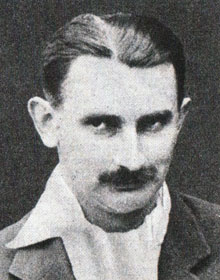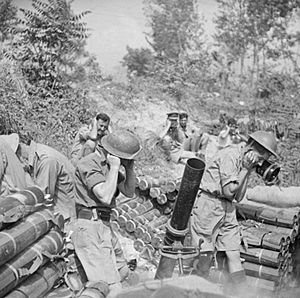Alexander Wilkinson facts for kids
Quick facts for kids
Alexander Wilkinson
|
|
|---|---|
 |
|
| Born | 6 December 1892 Sydney, Australia |
| Died | 19 September 1983 (aged 90) England |
| Allegiance | United Kingdom |
| Service/ |
British Army |
| Years of service | 1913–47 |
| Rank | Colonel |
| Unit | Army Service Corps Coldstream Guards |
| Commands held | 14th Battalion, Queen's Royal Regiment (West Surrey) 99 Light Anti-Aircraft Regiment, Royal Artillery |
| Battles/wars | First World War Second World War |
| Awards | Distinguished Service Order Military Cross & Bar George Medal |
| Other work | Amateur cricketer |
William Alexander Camac Wilkinson (6 December 1892 – 19 September 1983) was a very brave British Army officer and a talented English cricket player. Born in Australia, he fought for the British Army in both the First World War and the Second World War. He received many important awards for his courage.
After the Second World War, he worked in Graz, Austria, helping to manage the country during the occupation. He also had a long career as a first-class cricketer, playing for 27 years. He was known as a very steady batsman, even though he played much of his career with a hand injury from the First World War. He was shot and almost lost his hand, but he still managed to play cricket very well.
Contents
About His Life
Alexander Wilkinson was born in Sydney, Australia, on 6 December 1892. His father, William Wilkinson, was also a cricketer for Middlesex and a doctor. When his family moved to Britain, Alexander went to Eton College, a famous school.
He first visited Austria in 1906, starting a long connection with that country. From 1910 to 1914, he studied at University College, Oxford. While there, he played cricket and was good at hurdling for the university. In 1919, he got engaged to Muriel French. He passed away in Sussex, England, in 1983, when he was 90 years old.
His Army Career
Serving in the First World War
Wilkinson joined the British Army in 1913 as a young officer. When the First World War began, he joined the Army Service Corps in 1914. Later, he moved to the famous Coldstream Guards.
He was promoted to lieutenant and then acting captain. In 1917, he received the Military Cross (MC) for his bravery. The award recognized his fearless leadership after his company commander was hurt. He walked around, even with enemy snipers nearby, to encourage his men. He also bravely led his company to capture a strong enemy position. He later received a second award, called a Bar, for his Military Cross.
After the war, he continued to serve in the army. He worked at the army's physical training school and was promoted to major before retiring in 1933.
Fighting in the Second World War
When the Second World War started, Wilkinson was called back to the army. He was a lieutenant colonel leading the 14th Battalion, Queen's Royal Regiment (West Surrey). One day, some of his soldiers accidentally walked into a minefield. Several were killed, and one injured soldier was still moving in the middle of the dangerous area.
Even though a doctor thought the soldier wouldn't survive, Wilkinson bravely went into the minefield by himself. He managed to rescue the wounded man. For this incredibly brave act, he was awarded the George Medal (GM) in 1941.
His unit later became the 99th Light Anti-Aircraft Regiment, Royal Artillery. During the Allied invasion of Sicily in 1943, his regiment helped protect the landing beaches. Wilkinson described the landing as "a very pleasant exercise... with sufficient enemy fire to make it mildly interesting," showing his calm attitude under fire.
In May 1944, during the tough Battle of Monte Cassino, Wilkinson showed great courage again. His regiment was supposed to create smoke to hide bridges over the Gari River. When he heard that one bridge was not covered, he drove there to check. He found that the officers and sergeant in charge were either killed or injured.
Under heavy enemy fire, Wilkinson walked across the bridge, carrying smoke canisters himself. He started the smoke screen again and gathered more men to keep it going. For these actions, he received the Distinguished Service Order (DSO), another very high award for bravery.
After the war ended, Wilkinson worked in the military government in Austria. He was known for his radio broadcasts in German. He retired in 1947, partly because he disagreed with the policy of sending people back to Russia against their will. He visited Austria many times later and received a special medal from the Styrian government in 1977.
His Cricket Career
| Cricket information | |||||||||||||||||||||||||||
|---|---|---|---|---|---|---|---|---|---|---|---|---|---|---|---|---|---|---|---|---|---|---|---|---|---|---|---|
| Batting | Right-handed | ||||||||||||||||||||||||||
| Bowling | Right-arm slow | ||||||||||||||||||||||||||
| Role | Batsman | ||||||||||||||||||||||||||
| Domestic team information | |||||||||||||||||||||||||||
| Years | Team | ||||||||||||||||||||||||||
| 1914–1939 | Marylebone Cricket Club (MCC) | ||||||||||||||||||||||||||
| 1914–1939 | Free Foresters | ||||||||||||||||||||||||||
| 1920–1931 | Combined Services | ||||||||||||||||||||||||||
| 1919–1931 | Army | ||||||||||||||||||||||||||
| 1927 | Harlequins | ||||||||||||||||||||||||||
| 1923 | Gentlemen of England | ||||||||||||||||||||||||||
| 1913–1914 | Oxford University | ||||||||||||||||||||||||||
| 1912 | HK Foster's XI | ||||||||||||||||||||||||||
| First-class debut | 30 May 1912 HK Foster's XI v Oxford University | ||||||||||||||||||||||||||
| Last First-class | 28 June 1939 MCC v Oxford University | ||||||||||||||||||||||||||
| Career statistics | |||||||||||||||||||||||||||
|
|||||||||||||||||||||||||||
|
Source: CricketArchive, 18 May 2008
|
|||||||||||||||||||||||||||
Wilkinson was a right-handed batsman and a right-arm slow bowler. He played for the Sussex second team in 1910, but never for the main county team.
He had a long and successful career in first-class cricket, which lasted over 25 years.
- He played his first first-class match in 1912 for HK Foster's XI against Oxford University.
- The next year, he played for Oxford University and earned his "blue" (a special award for university athletes) by playing against Cambridge University.
- He continued to play for Oxford University in 1914, but his performance wasn't as strong that season.
Playing After the War
During the First World War, Wilkinson was shot in his right hand. He almost lost it, and the injury left his hand weak. He could still hold a bat, but it made fielding difficult on his right side. Despite this, he kept playing cricket and was never seen as a weakness on the field.
He returned to first-class cricket in 1919. He played for the Free Foresters and the Marylebone Cricket Club (MCC). He also played for the British Army cricket team for the first time against the Royal Navy.
In the 1920 season, he played for the Free Foresters and the Army again. He also made his debut for the Combined Services cricket team. He played many non-first-class matches too, for teams like the Old Etonians.
In 1921, Wilkinson played against international teams for the first time, facing the Australians with the Combined Services team. He continued to play regularly for the Army against university teams and the Navy.
That winter, he went on a tour with the MCC to Australia and New Zealand. He played in 11 first-class matches during these tours. Back in England, he played for the Army and also in the important Gentlemen v Players match. He continued to play many matches for the Army throughout the 1920s, sometimes against international teams like South Africa and New Zealand.
In 1927, he toured Egypt with the Free Foresters, playing against the Egyptian national side. He also captained the Army team in his last first-class game for them in 1931.
Later Cricket Years
In 1933, Wilkinson played for Egypt and even scored a century in one match. He returned to first-class cricket in 1934, playing regularly for the Free Foresters and the MCC against university teams. His last first-class match was in June 1939.
He continued to play club cricket even after the Second World War. He scored a century in his very last game, which he believed was his 100th century in all cricket matches.
His Cricket Numbers
In his 89 first-class matches:
- He scored 4,785 runs.
- His average was 31.48 runs per innings.
- He made eight centuries (scores of 100 runs or more).
- His highest score was 129 runs, which he made in just 90 minutes for Oxford University in 1913.
- He took 12 wickets (getting batsmen out) at an average of 32.08.
- His best bowling figures were 4 wickets for 32 runs, which happened in 1913. All his wickets were taken in that season.
Golf
Besides cricket, Wilkinson also played golf. He represented the Household Brigade and played for the Harlequins golf club.


